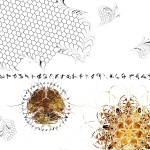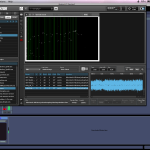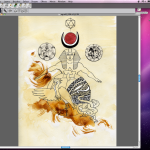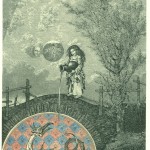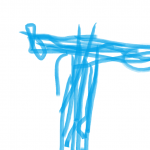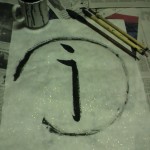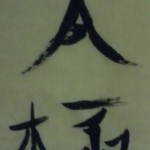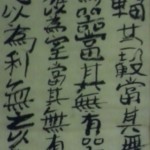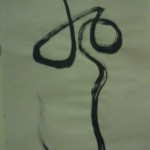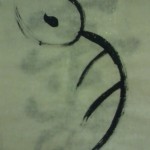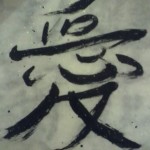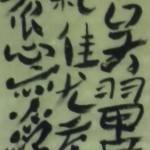Category Archives: term paper
Ab – Spring Term Paper (Anthology)
A is for Alchemy
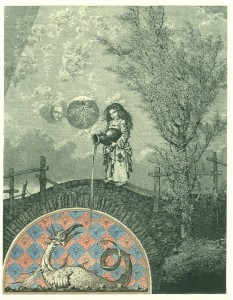 Alchemy, or the “Art of Black Soil”, is a vast field that has spanned several millenia and influenced some of the greatest scientists and thinkers from antiquity to modern times. The student will be undertaking a field study that seeks to understand the Alchemist’s worldview by researching its history and psychology and observing the process of solve et coagula (dissolution and re-synthesis) in his own art, music, and poetry. The alchemical process of transmuting matter from one form to another is a metaphor for the constant recycling of elements found in nature, the psyche and the neuronal recycling of the human brain. The student seeks to show that perhaps more fundamental than the exoteric concerns of alchemy are its esoteric ones, for in order to shape the world around us, we must first distill the elements of our own psyche in a metaphorical suffering, death, and rebirth. Jung saw that the Alchemists where in essence projecting their psychic or inner worlds onto the alembics of their laboratories. For the Alchemists, their work was the work of the divine. They were immersed in the sacred by their work as homo faber and as creator and manipulator of tools. They took their inspiration from the natural world around them and saw the universe as an animated sentient life-form, as evident in their belief that the ores they worked with were embryos that took gestation in the matrix of the Earth or Petra Genetrix. The student hopes to show that matter and psyche are inseparable and that just as the Earth is a womb, so is the mind a matrix for the birth of all things. From Aether, to Mind, to Muscle to Machine humans have become a conduit for the creative force that animates the universe, and by working with this principle, will align themselves with the work of the Divine. The Alchemists realized long ago, as the texts attributed to the mythic Hermes Trismegestus tell us, that the microcosm mirrors the macrocosm, or, “that which is above is like that which is below”. The student will be using his skills in digital music and media as well as his knowledge of poetry to create an anthology of works that illustrates the composting processes that are ubiquitous in the natural world. He will be combining his knowledge and use of organic as well as synthetic mediums to show how the composting of sounds, images and language recycles the neurons of the Alchemist. Jed Rasula addresses the composting of language when he writes “poetry is language disclosed as paradox, where naming does not re-present but dissolves and then reforms creation, where the speaker too is dissolved into the act of speech and reemerges…”
Alchemy, or the “Art of Black Soil”, is a vast field that has spanned several millenia and influenced some of the greatest scientists and thinkers from antiquity to modern times. The student will be undertaking a field study that seeks to understand the Alchemist’s worldview by researching its history and psychology and observing the process of solve et coagula (dissolution and re-synthesis) in his own art, music, and poetry. The alchemical process of transmuting matter from one form to another is a metaphor for the constant recycling of elements found in nature, the psyche and the neuronal recycling of the human brain. The student seeks to show that perhaps more fundamental than the exoteric concerns of alchemy are its esoteric ones, for in order to shape the world around us, we must first distill the elements of our own psyche in a metaphorical suffering, death, and rebirth. Jung saw that the Alchemists where in essence projecting their psychic or inner worlds onto the alembics of their laboratories. For the Alchemists, their work was the work of the divine. They were immersed in the sacred by their work as homo faber and as creator and manipulator of tools. They took their inspiration from the natural world around them and saw the universe as an animated sentient life-form, as evident in their belief that the ores they worked with were embryos that took gestation in the matrix of the Earth or Petra Genetrix. The student hopes to show that matter and psyche are inseparable and that just as the Earth is a womb, so is the mind a matrix for the birth of all things. From Aether, to Mind, to Muscle to Machine humans have become a conduit for the creative force that animates the universe, and by working with this principle, will align themselves with the work of the Divine. The Alchemists realized long ago, as the texts attributed to the mythic Hermes Trismegestus tell us, that the microcosm mirrors the macrocosm, or, “that which is above is like that which is below”. The student will be using his skills in digital music and media as well as his knowledge of poetry to create an anthology of works that illustrates the composting processes that are ubiquitous in the natural world. He will be combining his knowledge and use of organic as well as synthetic mediums to show how the composting of sounds, images and language recycles the neurons of the Alchemist. Jed Rasula addresses the composting of language when he writes “poetry is language disclosed as paradox, where naming does not re-present but dissolves and then reforms creation, where the speaker too is dissolved into the act of speech and reemerges…”
ABCs and 123s – weekly log and field notes
- A – Log Week 9 June 4, 2013 16 hours – reading (This Compost, Neuro, The Midnight, various poetry, The Forge and the Crucible, Creative Mythology, Transcendental Magic, etc). 8 hours – sound design and digital art utilizing granular ...
- A – Log Week 8 June 4, 2013 16 hours – reading (This Compost, The Forge and the Crucible, The Alchemy Reader, Creative Mythology, Neuro, various poetry, etc). 5 hours – sound design with granular processing in Ableton Live, ...
- A – Log Week 7 June 4, 2013 16 hours – reading (The Alchemy Reader, Jung’s Psychology of Alchemy, Creative Mythology, Neuro, This Compost, various poetry, The Forge and the Crucible, The Red Lion, Timeaus). 8 hours – software ...
- A – Log Week 6 June 4, 2013 16 hours – reading (The Alchemy Reader, The Forge and the Crucible, Creative Mythology, This Compost, Transcendental Magic, The Red Lion). 10 hours – software design (granular scrubber design in Reaktor ...
Neuro Reveries
- A – Neuro Reverie Week 9 June 4, 2013 “Despite their many differences, it is possible to identify a general picture of “the self” and “the person” emerging from contemporary developments in the brain sciences. In this picture, consciousness, ...
- A – Neuro Reverie Week 8 June 4, 2013 “The contemporary Western conception of the Self – individualized, bounded, with interior depth and temporal continuity, self-possessed, autonomous, free to choose – was not natural, given, or universal, it was ...
- A – Neuro Reverie Week 7 May 14, 2013 “Further, as we have seen in chapter 2, evidence from brain scans or other neurobiological tests does not ‘speak for itself’ – it must be spoken for. Images do not ...
- A – Neuro Reverie Week 6 May 8, 2013 “Becoming aware of the social and biological conditions that underpin our actions can, it seems, help each of us develop our competencies and understand and manage our cognitive facilities.” (pp.160) Developing ...
Poetry
- Music of the Spheres Word comes through the mist / of music Sacred secrets spiral / vibrating voices Ascending / harmony is drawn from / dissimilar proportions Pluck the / stars and watch them ...
- Satrotrope
- Word Yolk Seed of word-body decomposing / nutrient rich packet of information / Embryo /Yolk / new bodies for new soil / / new growth shoots green / stems flowering buds and ...
- Recycled Waste (Land) Ruin inevitable, yet bloom the land fallen dead. Memories of the lustful germ and rain.
- Armillary Sphere
Multimedia
A is for Alchemy: Granular Processing
Spring Term Papers
As readers we are not passive consumers of finished products. Each time we read we consummate with words in a ritual act of hieros gamos. The reader is motivated to reassemble texts into new and different word-worlds. The writer is responsible for the inception of a world that has more connections and meaning seeded within it than they can be possibly aware of. Poetry is especially rich with latent meaning and infinite possibility. Upon reading, poetry breaks down into nutrient rich soil, in turn fusing both the poem and the reader. This Compost: Ecological Imperatives in American Poetry explores this process by drawing on the works of a diverse array of American poets. In the book, quotation and tropic language are the composting mediums that turn the soil. The author, Jed Rasula, posits that language is biodegradable; it decomposes just like organic matter. Over time the poem starts to disintegrate and composite identities emerge from the ashes of the old. Word and language are animate; they live and die by the same rules that all life forms do. Populations of word organisms form semiotic biospheres; their overlapping meanings are sympatric cohabitations of ecological niches; their deaths alchemical transmutations. Like This Compost, this paper is both philosophical discourse and anthology of mutilation. Its focus is on the Nigredo stage of alchemy, or putrefaction, that occurs in the first stages of decomposition. It is in this stage that soma becomes fertile black earth, the word-matrix that births new life condensed into meaning.
Solve Et Coagula is a stitch work composition of word and image modeled after Susan Howe’s The Midnight. Here, the process of solve et coagula or dissolution and synthesis, is both method and subject. This paper is inspired by my work with digital sound design and the graphic arts as well as the mythos and history of magic. This work is intended to be a granulation and condensation of the language and symbols of alchemy as well an illustration of my creative process. I use the repetition of words and sounds (parachesis and alliteration) to induce a dissociated state within the mind of the reader. Out of this dissociation, composite identities emerge. The composting of image, word and sound is simultaneously a genesis of new life. Latent meaning is interlaced with the sounds of words and the images they evoke. The Midnight explores the thin veil between text and image, object and subject. Solve Et Coagula is a similar reflection on the space between music and noise and the matrix or margin between order and chaos. It is out of this place that new word-worlds are born. In alchemical terms, the adept fuses with their sacred texts, sewing pieces of their soul into the fabric of a universe perfuse with signs. This paper is intended to be coded and cryptic, mirroring ancient texts attributed to the likes of Hermes Trismagestus or Zozimos of Panopolis. By trying to decipher its coded language, the reader turns words like soil, populating its symbols with the germ of meaning. In The Midnight, Howe weaves her personal and familial history into a poetic memoir. Here, these characters are replaced by the mythic and archetypal figures of alchemy and magic.
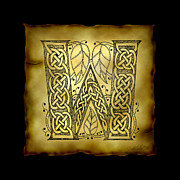
Wo – The Meditation of Craftsmanship Term Paper
The Meditation of Craftsmanship
“Flower, bird, wind, moon”
Shadow Writing
In the same way you, the reader, had to unscroll the Kakejiku attached to the top of this paper to see what it said, I invite you to unravel the connections and concepts alluded to within this paper. Because of length requirements, I had to abridge many of the explanations behind concepts that came together to form this paper, so I’ve veiled them with references existing within the paper and citations existing without it. Because of the influence of one of the principle texts, In Praise of Shadows, I think this is quite fitting in conveying the main themes I discovered in my field study. My professor Sarah Williams helped me coin the phrase Shadow Writing to describe this format. Shadows are cast in the paper that veil concepts only to be illuminated later, sometimes by looking back. I am casting a soft light on concepts, leaving them in the shadows while offering candles in the form of implied self reference (allusions to other parts of the text) and citations that you can use to illuminate the inner structure that built this paper. It is a participatory process, and like the Buddha said, “Walk your own path to illuminate the truth.” It is an attempt to more fully capture the fit the abstract concepts I encountered into the structured formula of an academic paper to more fully convey the experience of what these ideas are beyond the limits of an academic paper while still fitting into that formula. And as you’ll see, by embracing structure, the structure creates a pathway that transcends beyond the structure itself. The emergent properties that arise out of strict structure are what this paper is about, and the paper itself is written in a way to allow that. I don’t underestimate your intelligence and would prefer not to cater to your stupidity, so please engage your critical thinking skills and delve into the meanings folded within. So please, metaphorically unroll the scroll to find the full message contained within.
–
To the Japanese people, the ancient proverb on this scroll means, “experience the beauties of nature, and in doing so learn about yourself.” What conversations can we engage in with our surroundings where we learn about them and in turn, they show us something about ourselves? Johann Goethe, the 19th century poet and scientist, asked the same question. He developed a method of inquiry, known as Goethean science, which the author Craig Holdrege has outlined in his methodology of studying the skunk cabbage. This paper focuses on the aspect of “Delicate Empiricism”, a method comprised of seven components on how to engage in conversation with a phenomena you are observing. So what do Buddhism, Chanoyu (the Japanese tea ceremony), Yoga, woodworking, the science of reading, and poetry all have in common? Well my experience with woodworking a year ago led me to the pulling question that there was something in common between Buddhist meditation and the ways of traditional Japanese woodwork. I felt the same way while woodworking that I would while following a Buddhist meditation. I wanted to investigate what it was about these two things that created the phenomena of a similar experience. This is the component of Holdrege’s “Delicate Empiricism” that I call “Starting the Conversation.” As he explains it:
“When I enter into a conversation with nature my interest has been sparked by some experience, my attention has been caught. I’m presented with a riddle and begin asking questions, observing, and pondering. In this way I give the conversation an initial focus.” – Holdrege, 31
My interest had been sparked and I had an initial focus, a leading question that would drive my investigation. I wanted to know about the meditation of craftsmanship. As chance would have it, there was a class on Japanese woodcraft during the time of my field study. Realizing the potential for exploration here, I joined the class and formalized my leading question for an independent field study as part of the program As Poetry Recycle Neurons and posted this project description to our class website:
“The meditation of craftsmanship is a firsthand investigation into the shared qualities of Buddhist and Yoga meditation with traditional Japanese woodcraft and to see how these techniques create a physical space that facilitates an integral sensory experience between mind, body, and spirit, all encompassed in the Chanoyu tea ceremony. The student will show how practicing Japanese woodcraft and participating in the Chanoyu tea ceremony invite meditation that “recycles neurons”, an essential process in further developing critical thinking skills. Working with the Chanoyu: Traditional Japanese Culture and the Way of Tea program, the student will join in the construction of a traditional Japanese tea house on campus and practice Chanoyu tea ceremonies with the class.”
From this you can see that the initial question morphed. As a part of the woodworking course, we were to learn Chanoyu so we could carry out a tea ceremony upon completion of the tea house and to gain a better sense for the essence of the building we were constructing. I realized with woodcraft and Chanoyu both involving rhythmic, purposeful movements. Buddhist meditation prescribes stillness of body and mind. I wanted to know how these activities facilitated meditation even if physical movement was involved, so I decided to include another form of meditation that used physical movement: Yoga. As you can see, the conversation was already developing.
Now that I started the conversation, I had to be open and receptive to the connections that would pop out along the way. I call this “Developing the Conversation”. This is what Holdrege describes in the second and third components of Delicate Empiricism:
“If the focus I bring is too narrow and too rigid, we don’t have a conversation, we have…(one-sided questioning)…. With this awareness present at every moment, the conversation is imbued with an atmosphere of openness… a kind of animated looking forward to things unexpected that may arise.” – Holdrege, 31
What I found through studying the cultural aspect of Chanoyu and the philosophies of Japanese architecture is that Ma was the uniting factor between all these aspects of my question. So at this point it is paramount to convey what Ma is before we continue any further…
–
Take this pause to breathe
Notice the light coming in where you are right now. Notice where the light reaches a little less. Now where the light doesn’t reach at all. Do you see anything there? What is in that darkness, that mystery?
Breathe again
Now look back to the light. Do you feel any difference between the two places? If so, try to find the space where the difference begins. Trace the light away into the darkness and find where the light ends and the darkness begins. This journey may take a long time and you may get to a different place each time. The difference in the objects or the spaces is just that they are there to bring awareness to each other. But when we try to find the boundary between light and dark, it can be illusory. Ironically, this duality serves to show us that there is no separation, that all is one.
Perceive the world as a bubble. Perceive the world as a mirage.
If you see the world in this way you render the Lord of Death powerless.
– The Dhammapada
Ma is… well, Ma can’t really be described. It must be experienced. But think about it this way; Ma is all the blank space on this page surrounding the words. Ma is the pause you take between each sentence. Ma is the gaze between two people’s eyes. Ma is the darkened pupil at the center of those eyes. Ma is the stillness of a pond in the morning. Ma is more of a feeling than it is a thing. Ma is where poetry comes from. It is any space between shadow and light that the imagination fills with meaning. It’s not so important to define Ma as to realize how Ma defines things. Ma breaks down boundaries and sometimes builds them up just to show that they’re not needed.
Essentially, I found that Ma is the experience of meditation. It’s a time to pause and reflect. Ma is essentially what the Buddhists would call Dhamma. In Bikram Yoga it would be Chi. And Ma is a central cultural ideal in Japan. As our Sensei Professor Tomoko in Chanoyu explained to us, it is inherent and instinctual for Japanese people because they grow up with it in their culture and has been a part of their history for so long.
The Chanoyu tea ceremony seeks to bring Ma into the atmosphere of the tea house. Contrary to what I thought, you do not necessarily take things away to make more space for Ma, but you add Ma to the space of your choice. So instead of cleaning a cluttered room, you add Ma to it. Everything about Chanoyu is centered on Ma, from the lighting to decorations to the preparation of tea to the gestures and conversation between guests and host. What’s more is that through the architecture portion, we learned that the tea house itself is built to harness Ma and invite it in to stay.
A Japanese tea house, or Chashitsu, is designed contrary to most European and western style buildings. It’s simple, elegant, and humble components are comprised to frame the space within and around the structure rather than to the structure itself. It is maybe best illustrated in the framework of the house. Over a thousand years has refined carpentry in Japan to have some of the most complex joinery and internal frame structures of any culture on the planet, yet, this elaborate constructions are very purposefully hidden behind walls and ceilings or in the beams themselves, even when it’s not absolutely necessary. This is simply to conceal the “clutter” and provide blank, tranquil spaces for the people who would dwell in the space. It makes an interesting meditation when you are creating these elaborate joinery structures. You may work for hours and days on a hopelessly complex geometric configuration, carving out negative space and tenons to fill them all to be hidden away from sight as long as the building stands. It’s as if you were to paint the Mona Lisa and then cover it in a permanent veil when you were finished. That, in essence, is Ma. For me, this reminded me of the hopeless complexity of nature, the infinite mysteries dwelling within each thing. Our yoga instructor at Hot Yoga in Olympia reminded us of the complexity within our own bodies as we compressed and then stretched different areas with each pose. Anitol, the owner and instructor, said we were creating miniature tourniquets when folding our legs into our chests, where each cell becomes deprived of blood and oxygen, cut off from the rest of the body. It starts into panic mode and then when we release and stretch in the opposite direction, breathing deeply, freshly oxygenated blood rushes in and the cells make the most of it while they can in their panicked state, reaching satiation. I’m not directly controlling that. They do it on their own. I’m unconscious of this whole complex interaction within my body just as I’m unconscious of the complex joinery behind the walls and in the ceiling when I’m in a tea house. Yet, I do know that now and so am conscious of it on a higher level. This ascension is what The Dhammapada refers to as “mindfulness”. It is to be aware of your surroundings including undercurrents and subtleties. This awareness is a key to direct perception of Dhamma, which creates a reverie of what is.
Mindfulness is the path to immortality…
With this understanding, the wise…
Rejoice in mindfulness
– The Dhammapada
This awareness of complexity may seem counter to the stillness sought after with Buddhism and Ma, but it’s that awareness, that mindfulness of the complexity that brings a sense of wonder. You can sit in reverie of what is, allowing your imagination to fully feel and embrace the phenomena you are a part of. You reach that initial state of curiosity, wonder, and openness that began the conversation in the first place. In Gaston Bachelard’s book The Poetics of Reverie, he celebrates another take on value of being in a state of reverie:
“The importance of phenomenological inquiries lies in the complete illumination of the awareness of a subject who is struck with wonder by poetic images… The new born poetic image – a simple image! – thus becomes quite simply an absolute origin, and origin of consciousness. In times of great discoveries, a poetic image can be the seed of a world, the seed of a universe imagined out of a poet’s reverie.” – Bachelard, 1
It can be said that all of traditional Japanese aesthetics, of the tea house, of the tea ceremony, are made to be poetic images. Even the scroll pictured in the beginning of the paper is written as poetry and in a poetic style, the “grass style”, of calligraphy, all to create the atmosphere of reverie for the present moment and being in it. The phrase itself symbolizes the poetic grammar of Japanese. Those four words in the scroll are understood to mean so much more. And it’s not the only example. Jun’ichiro Tanizaki in his book In Praise of Shadows describes his reverie for the shadows and low lighting of traditional Japanese houses, the wonder and admiration that they can create for the people and objects in them as well as the space itself. He even describes his love for a traditional Japanese toilet in which one can sit in peace because of the dark colors and view of nature as opposed to the white tile, brightly lit washrooms of western society. If Dhamma can be said to be reverie and Ma can be said to be Dhamma, then it must be that Ma creates reverie, a poetic image that inspires wonder and appreciation at the complexity of what is. If it is understood that Chi is Dhamma as well, then it must be so that the yoga poses are poetic images that create reverie. Reverie is the meditation that connects all aspects together.
I decided to write a series of 6 haikus each week to convey my reverie and meditations from working with wood, hot yoga, and the Chanoyu ceremony. Many of the ancient tea houses, especially the more extravagant ones of nobility and royalty, were used as spaces to write poetry and music and make art while reflecting on the beauty of the universe. I thought it was fitting to create poetry in a uniquely Japanese style to document my processes and experiences as well. My commentary is alongside the poems in green.
What I learned from this field study, beyond the questions I asked, was that structure is a means to a higher form of freedom. What this whole conversation told me was that any strict, ritualized process will inevitably create emergent properties that operate outside the mode that created them. In the precise, predetermined choreography of the Chanoyu tea ceremony, the mind is free to wander about the mindful beauty that has been put into every aspect of the tea house by the use of Ma. The tea house is only held together by the builders following very specific prescriptions for which joints go where and how they are constructed, which allows the glorious structure to stand and provide a space for this tea ceremony, and furthermore, highlight the nature surrounding it to show how it blends with the landscape with no difference at all between them. The disciplined recipe for sitting quietly and contemplatively during Buddhist meditation while reciting meditations to oneself is a way to reach higher enlightenment and understanding of yourself and the world and the boundaries and connections between the two. Yoga requires strenuous exercise to put yourself into compromising positions that ultimately build further connections in the body and in the heart and mind as well. Even to the haiku I wrote for this assignment; I don’t typically write using form, preferring freeform. I found in this exercise though, that the limits of the structure made me think more thoroughly about the words and phrases, finding ones that more accurately portrayed the feeling of what I had learned more so than what I think freeform could’ve done. So after finding out what the meditation of craftsmanship is, it left me with this meditation to think about as I craft my future into limitless shape.
Therapeutic Child Crafts
Siproena Johnson
As Poetry Recycles Neurons
Feb.20.13
Field Study Term Paper
Therapeutic Child Crafts as Chance to Heal-Abstract
How do humans sustain the ambition to learn? What keeps us curious? Do adults teach children or have roles shifted? Can these roles be equal or more circumstantial? Personality; can it be found in portraiture? What is truly lost when the arts are not taken into account as a progressing factor in human development and successful sustainability? Questions compile as we try to find the best teaching strategies among hundreds of theoretical practices. This journey I now share with you traces back to Craig Holdrege and his piece; Doing Goethean Science that invites the reader to look beyond the immediate subject as such and pull out the deepest connections surrounding it. I had the opportunity to follow his 7 steps in my own observations and apply delicate empiricism for my assessment of the situations based on prior knowledge and this current experience. The child’s mind from infancy thrives on interaction whether this is from another person, animal object, or commonplace environment.
Passionate Beginnings
Children inspire me to continue questioning my daily interactions with all these and then some. Children have such a resilient nature compelling me to join them in their folly. The studies and “cognitive-stage theory” of Jean Piaget is widely spread across the productions of child oriented paraphernalia. Items for children, such as the diapers, drink holders, toys, and books to name a few, are marketed using the idea of stages as a measurement of progress. John B. Watson believed that conclusions about human development and functioning should be based on observations of overt behavior rather than on speculations about unconscious motives or cognitive processes that remain unobservable. Both of these theories; Piaget’s and Watson’s have been the strongest threads meshing with my own regarding the way humans have and can learn to engage with each other. Suppositions with little feasible knowledge can and has been a dangerous recurrence in our history of learning from one another. When a child is assumed to have achieved a “stage” as Piaget would put it, pressures to uphold these expectations according to a child’s age can cause a breach in basic skills. The children I have practiced crafts with have shown what may be felt as a delay in progress when compared to children in their same age group but it must be taken into account that we learn in different ways creating a need for more patience, practice, and exposer to an activity.
My Engagement and Sense of Boundaries
A family that I have had 6 years and counting of experience with reminds me of a timeworn saying but with a twist. This family consists of quadruplets; 2 girls and 2 boys born January 1st to military parents. They have had the influences and gained knowledge some of the average non-military parents wouldn’t be so blunt as to share partially because the question of mental maturity arises and the quadruplets parents believe it is necessary for the children to receive an honest answer whenever an inquiry is made. It is said, “A little knowledge is a dangerous thing.” In other words, this means a small amount of knowledge can mislead people into thinking that they are more expert than they really are. I can apply this thought directly with one child in this set of quads who has had some tastes of abstract artists’ work. It was funny to hear these words as a watercolor activity was practiced one evening. “This is how you make real art!” as the paintbrush thrashed haphazardly against the paper with a faint hue of orange. She decreed this statement a few more times presenting her paper to her sister and brothers. I knew this particular child to be the most outspoken amongst her siblings but where does a 6 year old get this? I’ve known the children’s mother to be just as if not more frank and candid in many occasions so the girl’s outburst simply gives me a tickle so I simply smile shaking my head. Mark Rothko and Michael Mazur came to mind with Mazur’s work Rocks and Water XII of 2002 the strongest in relation to her brush strokes and Fields of 1996 in relation to her chosen color which was orange.
Recycling Neurons: Self in Theory
When we started the arts and crafts evening, it was a time of free form art and experimentation before I found a place to sit down. I agree rules are necessary as a means toward a harmonious state of being in the given circumstances. Experimentation is how learning is achieved even if the outcome is undesirable. Children who
are taught not to try or are withheld from learning opportunities encompassing life’s inevitable obstacles may be losing the chance to apply their highly inquisitive and creative minds to achieve a thoughtful resolution. Experimentation implores those with uncertainties to practice the system of trial and error in order to relieve uncertainties or curiosities completely or at least lessen them to a more manageable proportion. Inactivity can lead to more negative repercussions than it would to at least take the initiative and try new activities in moderation within an individual’s means. I notice that children are willing to voluntarily try something new at least once but then the novelty of the activity becomes lost as well as the interest and is set aside for good or resurfaces when others with the same interest invite the child to try again rather than pressure the child to finish what has already been started. I have learned to grow up as a military child, adolescent, and now a military wife. This lifestyle has a role in my perception whether I am conscious of it or not. For many children in this position during early childhood, the lifestyle can negatively affect their social development by way of frequent relocation of the entire family or deployment of the active duty parent. Some of the older children I have encountered adapt nicely while others rely on each other and activities that can be accomplished on one’s own such as drawing, writing, listening to music or writing their own songs. I was introduced to origami by my second grade teacher and the librarian who selected an origami book from those the library was either donating or discarding due to wear. This craft ultimately stuck and has helped me cope during stressful situations or lengthy melancholy days. The long pharmacy wait periods for instance have been times I can occupy the children’s minds with the origami; the portable paper craft that it is. It comes in handy for the adults as well because it transitions the focus from the anxiety building with wait time, antsy children eager to return to the entertainment they have at home, and possibility of losing the place in line if they leave momentarily for a snack from the facilities found in the ground floor of the medical center. I recall those days while my father, active duty at the time was in the same state; Texas, but I could only interact with him via my mother’s words. He was stationed in Killeen and I was losing trust in these messages because they were often released during times of pure anger and frustration in regard to all she had to put up with. This for me translated into my existence as the problem in addition to my frequently flaring chronic illness. I was not reassured this perception was not at all accurate but rather was told to simply do as I’m told without back talking. I noticed the children working with me to make some origami projects these past weeks seemed timid to ask questions while the parent told an older sibling to often “hush up” as a question was emerging from her child’s mouth. Our mother’s military background before my brother’s birth was showing during the feuds her and I would have as I grew older and more aware of my parent’s history. I became one of those older children; finding other activities to occupy my mind such as puzzles, drawing, new crafts. As my brother reached 9 years of age, he came to understand me more we became more attached than ever seeing each other as the more compassionate and open minded sounding boards than our own parents. He, from his own experiences alone with our mother, began to see and feel for himself the toxic environment we were growing up in before our parents official separation and divorce while at the same time, attempts to persuade our thoughts of the qualms in this lifestyle as being normal were made. He, although younger, found me to be more than an older sibling; he began to see me as a close friend who he can always confide in. This ability to grow up with a sibling became a bridge for understanding how to reach the minds of the children I try to teach.
The Art of Writing to Soothe the Mind
In later years, writing became a strength seen by others reviewing my work. I passed these compliments at first with doubt and continued to write short stories and poetry while mixing experience with wishful thinking in the development of each piece. The children’s imaginations in my neighborhood would show as they shared an experience from school or other locations even when their words were hard to initially understand in the speed with which they spoke. While gaining more experience in teaching the crafts I have found as therapeutic for many years, I found this in itself a pleasant experience and reason to continue writing poetry to ease my mind. Using the imaginative power an oral story can have when a child shares it reminded me it would be good to work on sharing work orally whenever possible to get more feeling across to an audience. While my primary focus was to teach children these crafts, adults alike began to take notice of the children enjoying the way I teach. There came a point where wishful thinking became more prominent in my pieces as in this piece I call Age.
Poem: Age
Age is simply a landmark in time
For people, there is a beginning and the end of a lifeline
Aged for foods like cheese and wine are perceived as matured
But why does this not in all aspects pertain to people as science claims could
Our minds may perceive age as a level of authority
Often greater numbers receive the higher respect while lower ones minorities are those we could forget
Our behaviors often contrary to the numerous trends or stigmas attributed to a given age
The higher the number does not necessarily mean one is entitled to more power, grace or fame
How one has lived, practices become a key to earn the respect of another living or past being
Age is a number that does not grant automatic respect
Age is a number increasing with every year
It does not grant one with a higher number to impede on an age with lower stature
The age on either end, whether high or low, have experiences to teach one another
These can be shared to move toward positive growth
Positive growth; maturity, like that pleasant cheese and wine
These are composed of ingredients that help the pleasant taste become defined
Trials and errors in a journey are sure to occur
With creativity; ingenuity continuously stirred
The possibility for clarity among each other is no longer a blur
Prior Inspirations and Revealing My Passion
As I began teaching children as part of the curriculum required for my Associates degree from Bates Technical College, I began to see and feel my transformation into the teachers I loved to learn from as a child in elementary schools, and wished other teachers could be in latter K through 12 schools I had attended. A librarian was also a key inspiration for my moth to a flame attraction to the craft of origami alone. The characteristics I enjoyed in these teachers then and find myself more willing to respond to now, would awaken in my teaching styles at Bates. These characteristics include patience, humor, broad perspective, and most of all a love for their work. It has been said that young children and even infants have somewhat of a sixth sense when it comes to people they are drawn to and happy to be with on an ongoing basis because they can feel these positive attributes in new people. In my experiences so far, this theory has fit from the time I’ve worked as a caregiver in the infant room and preschool teacher in the Bates Childcare facilities to present day interactions.
In the neighborhood I now live, I was still kneeling down or simply sitting with the children to demonstrate a particular step for a project. The primary instructors in each Bates facility noticed how I kept the children engaged in activities presented to them without any effort while the professional instructors themselves found more trials were necessary to calm and engage in activities with the usually cranky infant or preschool age child with documented behavioral issues. This came ease of teaching came to the attention of parents in my current neighborhood these past weeks. I did not realize this at first but it was brought to my attention that I consistently knelt down to the children’s eye level or simply sat down on the floor to achieve this angle. The children could see me as one of them rather than another adult telling them what to do throughout the day and it made it easier for them to have trust and willingness to learn from me as well as with me. Perhaps this practice of interacting at eye level was a positive attribute I gained from those stern talks I received as a child on through adolescence from my military parents although these particular encounters with them were far from enjoyable. Upon completion of this portion of my studies, I still found myself wanting to return to Bates and continue to work as a teacher in the childcare and preschool facilities because this job was more than simply time for a paycheck, it was also very energizing to be among others eager to share their voices and creations. The quads help me once again as I visit them in their home, why I continue to share the various arts and crafts I have learned.
Free Art
Exploration of the mediums, variety draws them in
Each child finds the supplies he or she wants for the arts and craft to begin
One, a girl, first to dive directly into the bag of supplies
Brothers and sister, next to scurry toward the bag and grab what attracts their eyes and minds
The first girl pulls out a pack of oil pastels; I tell her what they are while her expression questions the use
She then finds a spot of her own, immediately depicting images with almost all the colors available to choose
I sit back and watch as the children have their way
This time a boy has trouble with the modeling clay
His brother and sisters hear his cries for some assistance
A sister mashes the clay with a medium rectangular wooden block
The other tries the wedge to divide the piece that she’s got
The brother joins in to help his siblings out
He rolls the dough on the table but the brother struggling has his doubts
He returns to his section of green clay and this time the rolling works
I congratulate him in his persistence to continue despite the quirks
Trial and error becomes the learning process this time combined with imagination
The siblings came together to help their brother complete his creation
C- Term Paper

Ta – Winter Term Paper

O – Seven Steps Towards a Delicate Empiricism
I – Winter Term Paper
- I is for Ink
- Tai Ji
- Tao Te Ching #11
- circle practice
- eternity
- wind- regular script
- Self Portrait in Wind
- change
- love
- grass script cutup poem #1
- visual poetry composition #1 (regular script)



